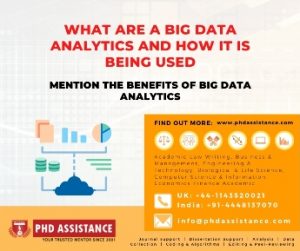In-Brief
- PhD Data Analytics & Big Data Services have data analysts, statisticians data scientists, predictive modellers, and other analytics professionals to analyze your growing volumes of structured transaction data
- Our expert in PhD Thesis on Big Data Analytics utilizes that commonly used for advanced analytic process
- PhD Guidance in Big Data Help Researchers to harness their data and use it to identify different patterns and new opportunity in research

Introduction
Big Data Analytics PhD is the complicated process of examining big data to uncover pieces of information, such as hidden patterns, correlations, customer preference and market trends that can help organizations make precise business decisions. It is a type of advanced analytics, which involve complex applications with various elements such as predictive model, statistical algorithms.
Big data analytics through unique systems and software can lead to positive research-related outcomes such as,
- New revenue opportunities
- More effective marketing
- Better understanding the needs
- Improved operational efficiency
- Competitive advantages over rivals
PhD Big Data Analytics Specialization come under three categories
They are structured, unstructured and semi-structured.
- Structured data sets: Comprises data used in its original format to derive the result.
- Unstructured data sets: It lies on without having a proper format and alignment.
- Semi-Structured data sets: It is the combination of both structured and unstructured. This category has a proper structure but lacks defining elements for sorting and processing
How big data analytics works in research
PhD Guidance Required Big Data offers various operations such as collecting, processing, and analyzing extensive data set to help the research.
- Data collection:
Data collection varies from a different organization. Based on the organization, they collect the data that can be both structured or unstructured data from the variety of source. Some data stored in data warehouses where research intelligence tools and provide outcome where professionals can access it easily. PhD Projects in Big Data analysis services helps to handle the complex set of data that is raw or unstructured.

- Data process:
Once the data collected and stored, it is adequately organized based on the organizational needs to get a target outcome on analytical quires, especially when it is large or unstructured data forms. And the available data is growing exponentially. The processing option is the batch processing that looks for big data blocks. Batch processing applies to the longer turnaround time between collecting and analyzing the data sets.
Stream processing is the type that looks at small batches that are shortening the delay time between the collection and analysis phase for easier decision making. The stream process method is a tedious process that is often expensive to conduct.
- Clean Data:
The data may be big or small, that requires scrubbing to improve their quality and also to get more substantial results to make the right decision for research. All the available data must be formatted correctly to get reliable information out of it. PhD Guidance in Big Data checks the presence of duplicative or irrelevant data that are in the data set. Raw data can be obscure and mislead the research by creating flawed insights.
- Data analyze:
It takes time to get PhD Research Topics in Big Data Analytics into a usable state. Once it is ready, the advanced analytic process can turn big data into insight. Big data analytics method include,
- Data mining group through large datasets to identify patterns and relationships by identifying incongruity data and creating data clusters.
- Predictive analytics utilizes an organization’s historical data to make justifications for the identification of future research risks and opportunities.
- Deep learning assumes human learning patterns by applying artificial intelligence and machine learning to layer algorithms and find patterns for the most complex and abstract data sets.
Big data analytics tools and technology
- Hadoop is an open-source tool that efficiently stores and processes big datasets in the group in commodity hardware. It is the framework that is free and also handles large amounts of structured and unstructured data, to make a valuable mainstay for any data operation.
- NoSQL databases is a non-relational data management systems that do not require a fixed scheme, making them an excellent option for big, raw, unstructured data.
- YARN stands for “Yet Another Resource Negotiator.” It is a component of last-generation Hadoop. The group management technology helps with scheduling and resource management which is in the cluster.
- Spark is an open-source group computing framework that utilizes implicit data parallelism and faults tolerance to provide an interface for entire programming clusters. Spark is applicable for both batch and stream processing.
- Tableau is a close-ended data analytics platform that allows researchers to prepare, analyze, collaborate, and share your research data insights. Tableau excels in self-service visual analysis, allowing researchers to ask new questions of governed Big Data in Official Statistics and allows to share those insights easily within the organization.
Conclusion
PhD Program Big Data Analytics uses technologies such as Hadoop, NoSQL brings cloud-based analytics that shows significant cost difference when it comes to storing large sets of data, plus they can identify more efficient ways of doing research right.
References
- LaValle, S., Lesser, E., Shockley, R., Hopkins, M. S., & Kruschwitz, N. (2011). Big data, analytics and the path from insights to value. MIT Sloan management review, 52(2), 21-32.
- Ankam, V. (2016). Big data analytics. Packt Publishing Ltd.
- Gandomi, A., & Haider, M. (2015). Beyond the hype: Big data concepts, methods, and analytics. International journal of information management, 35(2), 137-144.
- Guidelines to Write a Research Proposal for Neurology Research Scholars - March 19, 2021
- How to Choose a PhD Dissertation Topic For Economic Research? List out the Criteria for Topic Selection - March 11, 2021
- Beginners Guide to Write a Research Proposal for a PhD in Computer Science - February 19, 2021

